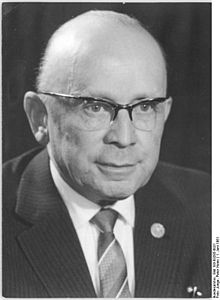Erich Correns (chemist)

Erich Paul Hubert Correns (born May 12, 1896 in Tübingen ; † May 18, 1981 in Berlin ) was a German chemist and President of the National Council of the National Front of the GDR .
Life
Correns was born in Tübingen in 1896 as the son of the biologist Carl Correns . After attending grammar school in Leipzig and Munster , he completed his military service. He took part in the First World War and met Richard Sorge here . From 1918 to 1922 he studied chemistry , botany and physics at the universities in Berlin and Tübingen . He was promoted to Dr. phil. doctorate and was from 1922 to 1924 as an assistant at the Kaiser Wilhelm Institute for Chemistry in Berlin and that of Max Bergmann led the Kaiser Wilhelm Institute for Leather Research in Dresden worked.
In 1925 Correns took a job as an industrial chemist at IG Farben in Elberfeld and in 1931 became head of the acetylcellulose plant in Elberfeld. In 1933 he was given the management of the copper and artificial silk factory in Dormagen . From 1937, he headed the construction of rayon - and rayon GmbH in the Thuringian Rudolstadt-Schwarza . Following measures by the authorities, he resigned as operations manager in 1939 and became a consulting chemist at Thüringische Zellwolle AG and the rayon-rayon ring . His Jewish wife was killed in 1939 when she was transported to a concentration camp . The two children ('half Jews') were not taken to the concentration camp. For this reason, and because of his mistrust of the role that old Nazis still had in the Federal Republic after the war, Correns, who was never a communist, took part in the construction of East Germany.
After the end of the war , Correns became director of the Rosenthal pulp and paper factory in Blankenstein in 1946 . From 1948 he took over the management of the Thuringian artificial silk works in Schwarza. In 1951 Correns became director of the Institute for Fiber Research of the German Academy of Sciences in Teltow . From 1951 he was a full member of the Academy. Correns headed the institute until 1962, and was succeeded by Hermann Klare , who would later be the long-time President of the Academy . From 1953 to 1959 he held a professorship for chemical technology in pulp production at the Technical University in Dresden. In 1956 Correns became Dr. jur. hc at the Humboldt University in Berlin . In 1961 he retired.
Correns was President of the National Council of the National Front from 1950 until his death in 1981 . From 1954 he was a member of the People's Chamber . In the same year he became a member of the central board of the Society for German-Soviet Friendship and the Presidential Council of the Kulturbund . From 1957 he was a member of the Research Council and from 1960 a member of the State Council of the GDR. He was a co-founder of the magazine “Fiber Research and Textile Technology” (later “Acta Polymerica”).
In 1954 Correns was one of the first 22 medal winners to receive the Patriotic Order of Merit in Gold, in 1965 the bar of honor for the Patriotic Order of Merit in Gold and in 1971 the Karl Marx Order . His urn was buried in the memorial of the socialists in the central cemetery Friedrichsfelde in Berlin-Lichtenberg .
Works (selection)
- 1922: Attempts on the course of the Beckmann rearrangement (diss.)
- 1944: Relationship between morphological structure and chain length in native cellulose fibers (co-author)
- 1944: Relationship between the morphological structure and the way technical pulp reacts
literature
- Dorit Petschel : 175 years of TU Dresden. Volume 3: The professors of the TU Dresden 1828–2003. Edited on behalf of the Society of Friends and Supporters of the TU Dresden e. V. von Reiner Pommerin , Böhlau, Cologne a. a. 2003, ISBN 3-412-02503-8 , p. 147.
- Short biography for: Correns, Erich . In: Who was who in the GDR? 5th edition. Volume 1. Ch. Links, Berlin 2010, ISBN 978-3-86153-561-4 .
Web links
- Literature by and about Erich Correns in the catalog of the German National Library
- New York Times: Prof. Erich Correns, 85, An East German Leader
Individual evidence
- ^ New York Times: Prof. Erich Correns, 85, An East German Leader , May 19, 1981.
- ^ ND of May 8, 1954.
- ↑ Berliner Zeitung , October 7, 1965, p. 5.
| personal data | |
|---|---|
| SURNAME | Correns, Erich |
| ALTERNATIVE NAMES | Correns, Erich Paul Hubert (full name) |
| BRIEF DESCRIPTION | German chemist and politician, MdV |
| DATE OF BIRTH | May 12, 1896 |
| PLACE OF BIRTH | Tübingen |
| DATE OF DEATH | May 18, 1981 |
| Place of death | Berlin |

